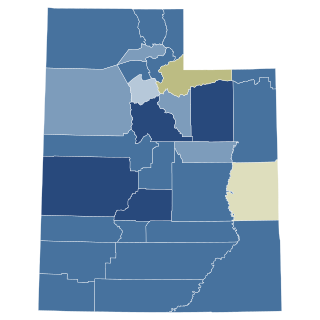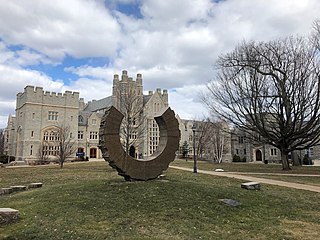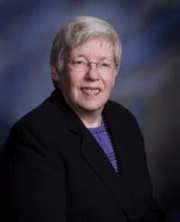Related Research Articles

Mary Carolyn "Jodi" Rell is an American former politician who served as the 87th governor of Connecticut from 2004 to 2011. Rell also served as the state's 105th lieutenant governor of Connecticut from 1995 to 2004 under Governor John G. Rowland,and became governor after Rowland resigned from office. To date,Rell is the last Republican and last woman to officially serve as Governor of Connecticut.

Utah Constitutional Amendment 3 was an amendment to the Utah state constitution that sought to define marriage as a union exclusively between a man and woman. It passed in the November 2,2004,election,as did similar amendments in ten other states.

The Iowa Supreme Court is the highest court in the U.S. state of Iowa. The Court is composed of a chief justice and six associate justices.

The University of Connecticut School of Law is the law school associated with the University of Connecticut and located in Hartford,Connecticut. It is the only public law school in Connecticut and one of only four in New England. As of 2020,it enrolled 488 students.

The Connecticut Supreme Court,formerly known as the Connecticut Supreme Court of Errors,is the highest court in the U.S. state of Connecticut. It consists of a Chief Justice and six Associate Justices. The seven justices sit in Hartford,across the street from the Connecticut State Capitol. The court generally holds eight sessions of two to three weeks per year,with one session each September through November and January through May. Justices are appointed by the governor and then approved by the Connecticut General Assembly.
Same-sex marriage has been legally recognized in Connecticut since November 12,2008 as a result of the Connecticut Supreme Court 4-3 ruling in Kerrigan v. Commissioner of Public Health that the state's statutory prohibition on same-sex marriage violated the Constitution of Connecticut and that the state's civil unions failed to provide same-sex couples with rights and privileges equivalent to those of marriage.

Joette Katz is an American attorney who is a partner at the law firm,Shipman &Goodwin LLP. She was an associate justice of the Connecticut Supreme Court,where she also served as the administrative judge for the state appellate system,and later was the Commissioner of the Connecticut Department of Children and Families. In various roles during her career she has had an impact on issues of state and national importance,such as:criminal law,capital punishment,civil rights and the right to education,eminent domain,same-sex marriage,LGBTQ rights,sexual assault,sex trafficking,and helping children in state care move from institutions to families.
Flemming L. Norcott Jr. is a former Associate Justice of the Connecticut Supreme Court. He was appointed to the Connecticut Superior Court in 1979 and remained there until his elevation to the Connecticut Appellate Court in 1987. He was appointed to the Connecticut Supreme Court in 1992. He also serves as Associate Fellow of Calhoun College at Yale University,as well as a lecturer. Justice Norcott received a Bachelor of Arts degree from Columbia University in 1965 and a Juris Doctor degree from Columbia Law School in 1968. He was born in New Haven,Connecticut.
Peter T. Zarella is a former Associate Justice of the Connecticut Supreme Court. Zarella sat on the court he was appointed by Governor John G. Rowland in January 2001 until his retirement on December 31,2016.

David M. Borden was a Connecticut Supreme Court Justice from 1990 to 2007.

Varnum v. Brien,763 N.W.2d 862,was an Iowa Supreme Court case in which the Court unanimously held that the state's limitation of marriage to opposite-sex couples violated the equal protection clause of the Iowa Constitution. The case had the effect of legally recognizing same-sex marriage in Iowa. In 2007,a lower court had granted summary judgment in favor of six same-sex couples who sued Timothy Brien,Polk County Recorder,for refusing to grant them marriage licenses.
Kerrigan v. Commissioner of Public Health,289 Conn. 135,957 A.2d 407,is a 2008 decision by the Connecticut Supreme Court holding that allowing same-sex couples to form same-sex unions but not marriages violates the Connecticut Constitution. It was the third time that a ruling by the highest court of a U.S. state legalized same-sex marriage,following Massachusetts in Goodridge v. Department of Public Health (2003) and California in In re Marriage Cases (2008). The decision legalized same-sex marriage in Connecticut when it came into effect on November 12,2008. There were no attempts made to amend the state constitution to overrule the decision,and gender-neutral marriage statutes were passed into law in 2009.

Martha Craig "Cissy" Daughtrey is a Senior United States circuit judge of the United States Court of Appeals for the Sixth Circuit.
United States v. Windsor,570 U.S. 744 (2013),is a landmark United States Supreme Court civil rights case concerning same-sex marriage. The Court held that Section 3 of the Defense of Marriage Act (DOMA),which denied federal recognition of same-sex marriages,was a violation of the Due Process Clause of the Fifth Amendment.
This article contains a timeline of significant events regarding same-sex marriage in the United States. On June 26,2015,the landmark US Supreme Court decision in Obergefell v. Hodges effectively ended restrictions on same-sex marriage in the United States.

Cardona v. Shinseki was an appeal brought in the United States Court of Appeals for Veterans Claims (CAVC) of a decision by the Board of Veterans' Appeals upholding the denial of service-connected disability benefits for the dependent wife of a female veteran. The United States Department of Veterans Affairs denied the disability benefits based on the definition of "spouse" as "a person of the opposite sex" under federal statute. On March 11,2014,the CAVC dismissed the case as moot after the Secretary of Veterans Affairs advised the Court that he would neither defend nor enforce the federal statute. Cardona subsequently received full payment of her spousal benefits,retroactive to her date of application.

This article addresses the history of gay men in the United States. Unless otherwise noted,the members of same-sex male couples discussed here are not known to be gay,but they are mentioned as part of discussing the practice of male homosexuality—that is,same-sex male sexual and romantic behavior.
Obergefell v. Hodges,576 U.S. 644 (2015),is a landmark decision of the Supreme Court of the United States which ruled that the fundamental right to marry is guaranteed to same-sex couples by both the Due Process Clause and the Equal Protection Clause of the Fourteenth Amendment of the Constitution. The 5–4 ruling requires all 50 states,the District of Columbia,and the Insular Areas to perform and recognize the marriages of same-sex couples on the same terms and conditions as the marriages of opposite-sex couples,with equal rights and responsibilities. Prior to Obergefell,same-sex marriage had already been established by statute,court ruling,or voter initiative in 36 states,the District of Columbia,and Guam.
In the United States,the history of same-sex marriage dates from the early 1940s,when the first lawsuits seeking legal recognition of same-sex relationships brought the question of civil marriage rights and benefits for same-sex couples to public attention though they proved unsuccessful. However marriage wasn't a request for the LGBTQ movement until the Second National March on Washington for Lesbian and Gay Rights in Washington (1987). The subject became increasingly prominent in U.S. politics following the 1993 Hawaii Supreme Court decision in Baehr v. Miike that suggested the possibility that the state's prohibition might be unconstitutional. That decision was met by actions at both the federal and state level to restrict marriage to male-female couples,notably the enactment at the federal level of the Defense of Marriage Act.
Anne Stanback is an American activist for LGBT rights and same-sex marriage.
References
- ↑ "Biographies of Supreme Court Justices". 2010 State of Connecticut Judicial Branch. Retrieved 2011-01-01.
- ↑ "Conn. court overturns same-sex marriage ban". NBC News news services updated 10/10/2008 3:14:33 PM ET. Retrieved 2011-01-01.
- ↑ Edmund H. Mahony (May 24, 2020). "Connecticut Supreme Court Justice Richard N. Palmer retiring after 27-year career that included decisions on death penalty, same-sex marriage". Hartford Courant. Retrieved 2020-05-24.